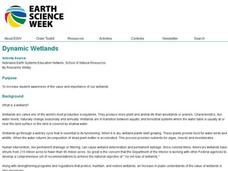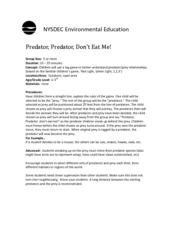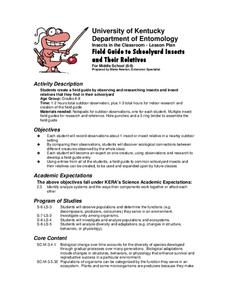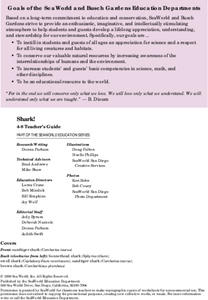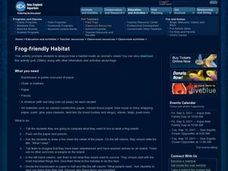Curated OER
It's Goin' Down; The Rain Forest
Students discover the global problem of deforestation. In this environmental instructional activity, students identify organizations on the quest to stop deforestation. Students also discover what they can do to solve this global dilemma.
Curated OER
Land Development and the Environment
Learners examine the relationship between land development and the environment. In this environmental stewardship lesson, students explore how population density, land development, transportation, and impervious surfaces take their toll...
Curated OER
Web of Life Game: Trout
Students explore the concept of food webs. In this food web lesson, students demonstarte the connection between species. Students use a ball of string show how the food web works, then have a class discussion.
Curated OER
CSI on the Deep Reef
Learners read about, discuss, and research chemotrophic organisms. In this chemosynthesis instructional activity, students discuss the differences between photosynthesis and chemosynthesis. They learn that chemosynthesis includes a...
Curated OER
Exploring Alaska's Seamounts - Volcanoes, Plates, and Chains
Learners examine the formation of seamounts in the Gulf of Alaska. In this seamount lesson, student focus on how the Axial-Cobb-Eikelberg-Patton chain was formed. They learn the associated vocabulary, and watch a teacher demonstration of...
Curated OER
Dynamic Wetlands
Students construct and observe a model of two different types of wetlands. In this wetlands lesson, students create a model of a wetland with constant drainage and a wetland that maintains a well-saturated soil. Students observe and...
Curated OER
Dibble Pond Ecosystem
Students collect specimen and analyze it. In this biology lesson, students analyze and evaluate the diversity found in specific environment. They use the correct terminology as they do their write up for the experiment.
Curated OER
Parasite Development and Life Cycle
If you are new to teaching agriculture classes, this outline may be helpful when you are preparing a lecture on parasites in livestock. In addition to lecturing on this topic, the lesson plan suggests that learners research the life...
Curated OER
No Escape
Via four student handouts, marine biology learners examine the topography and circulation cell of the Fieberilng guyot. Then they examine the number of individual hydroids counted at each depth. Pupils use the information to relate water...
Curated OER
Predator, Predator, Don't East Me!
To prep for a lesson on predator/prey relationships, get kids up and moving. This game is based on the game 'Red Light, Green Light' but employs the concept of predator vs. prey. This is not a full lesson but could be useful as an...
Curated OER
Feeding the Birds
Young scholars build bird feeders. In this aviary lesson, students build different types of bird feeders. This web page includes information on which type of feeder attracts which birds and what food to use with the certain feeder type.
Curated OER
Exploring Animal Habitats: Winter Changes
Students explore animals during the winter months. They discuss the changes that animals make during winter in order to survive. Students discuss migration, hibernation, and staying active during winter months. Students create various...
Curated OER
Holy Habitats or Meet Metamorphosis
Students examine the metamorphosis of frogs and how it adapts to its environment. They research how world pollutants are effecting the amphibian population.
Curated OER
"The Science Times"
Learners create their own newspaper after gathering information at the Museum of Natural History's Hall of Biodiversity.
Curated OER
Have You Seen Me? An Introductory Lesson on the Loss of Biodiversity
Students investigate environmental law and policies involving endangered species as well as discuss human impact on biodiversity through an Internet research project. Students create a milk carton of their "missing" endangered species.
Curated OER
Field Guide to Schoolyard Insects and Their Relatives
Your entire class works together to create an illustrated insect field guide. The intent is that they venture outside of the classroom, find a critter, and then research it using reference materials, insect books, and the Internet for...
Michigan State University
May I Take Your Order?
If you're a pest, come and get a tasty meal here! Scholars work collaboratively to construct a mini restaurant out of a shoe box and create a menu that feeds a pest their favorite food.
Curated OER
Animal Habitats and Their Management
Students review components present for a quality animal habitat and then explore a goose pond to find out what animals reside there. They learn how wildlife managers work with the land so everything can co-exist together.
SeaWorld
Shark!
Here is an impressive collection of lessons on sharks. In them, pupils undertake a serious study of sharks, their habitats, their social structure, and how humans adversely impact their existence. These lessons effectively integrate...
Roald Dahl
The Twits - The Furniture Goes Up
Work gets done faster when people work as a team. The ninth installment of an 11-lesson unit designed to accompany The Twits by Roald Dahl combines character education with research skills and creative writing activities. The lesson ends...
Desert Discovery
Leaping Lizards
Here is a fine biology lesson that introduces youngsters to reptiles. They study their feeding habits, their habitats, and the adaptations they must make to survive in their environments. The outstanding lesson includes two excellent...
Curated OER
Reel in Learning with Reptiles
Whether it’s all about a Jackson Chameleon or a North American Bearded Lizard, learners will be eager to embark on informational text with reptiles.
Curated OER
Frog Friendly Habitat
Learners create a frog friendly habitat. In this animal habitat lesson, students study what animals need to survive and then create a frog habitat from a shoe box. Learners write a report about frogs and present their habitats...
Curated OER
Graphing Predator/Prey Data
Students use data from the Camouflage Game (played with red and green yarn caterpillars) to create a composite bar graph to display the collected data. They interpret the data and form a conclusion based on the graphs. Teachers may use...







